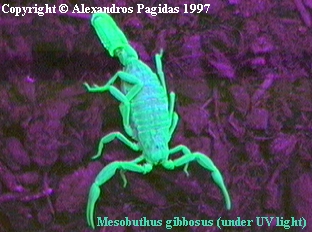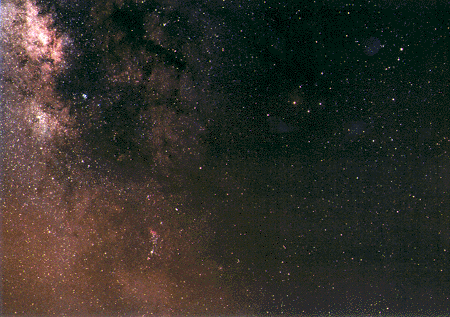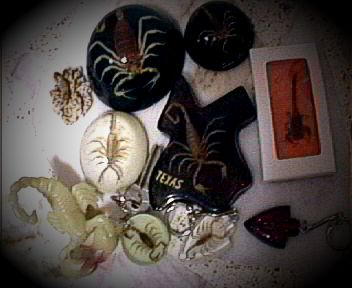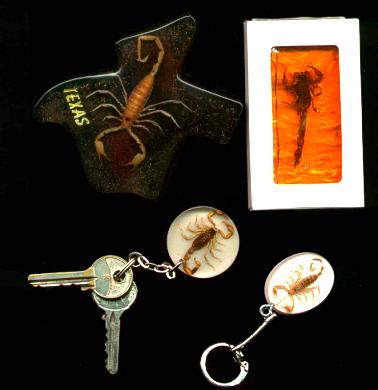
Thanks Alexandros Pagidas for the picture.
Other Interesting Facts about scorpions
Observing scorpions by itself is interesting. However, the scorpion still holds a surprise or two when one probe further.
Flourescence:
 |
Mesobuthus gibbosus put under ultraviolet light
showing pronounced flourescence phenomenon Thanks Alexandros Pagidas for the picture. |
In most public exhibits of scorpions, flouresence of scorpions is featured strongly.
Longwave ultraviolet light when shine upon the scorpion is absorbed and reflected as
greenish visible light. Other than scorpions, some sowbugs, millipedes, centipedes,
solfugids and even beetles are shown to exhibit flourescence.
Under the sun, the greenish tinge of the scorpion may be observed.
The exact substance causing the flourescence is not yet known but
is probably a complex of mucosaccharides and proteins. Recent studies by Dr Scott
Stockwell (pers. comm.) reveals presence of carotenoids which is at least partially
explain for this phenomenon. The flourescence is emitted from the surface epicuticle (aka
hyaline layer named by Dr Scott A. Stockwell) which is part of the integument which
includes epicuticle, mesocuticle and endocuticle. Such flourescence is observed even in
some of the fossils of euryterids (ancient scorpions). Even in specimens dried and mounted
or preserved, flourescence property is preserved. In fact, flourescence in alcohol
preserved specimens leads to the discovery of florescence in scorpions(1956).
It is observed that newly molted scorpions shows little or no flourescence. Also
intersegmental cuticle even in mature cuticle shows no flourescence. It is postulated that
the flourescence may be due to secretion of the scorpion or a by product of the tanning
process. However, long term exposure to high dose of UV has been observed to
decrease flourescent properties which indicate some degree of lability to UV light.
Rroglobitic (cave dwelling) scorpions not exposed to sun shows flourescence which seems to
disprove the need for tanning process. This and the fact that baby scorpions in the first
instar shows less flourescence, swings the argument in favour of the possibilty of
secretion.
The ecological advantage of having flourescence is not known and apparently UV light shows
little to no effect on the behaviour of scorpions. Koehler in his studies hypothesise that
the flourescence may help in the scorpion's UV senstivity. This may prove advantageous to
their nocturnal living.
Their flourescence when discovered has been been used extensively in their collection and
studies. Much advances in their knowledge and discovery of new species arises from this
peculiar property. However, I personally disfavour it unless it is for research purpose
otherwise the natural population can quickly deplete. Most scorpions with their very long
gestation period (even if compared to mammals) has relatively low recovery rate.
Scorpions in the Sea:
To many people, scorpions on the land is distressing thought. Few knows that
scorpions can also be found in the sea or more correctly, the beach. Most of the following
information is extracted from 'Biology of Scorpions' by Polis. At least 10 species of
scorpions (Polis) can be found on the beach. Above the high tide line on some beaches, it
is found to have abundant scorpion life mainly of the Centruroides sp. Scorpions
like Vaejovis littoralis can be found among the Sargassum algae while Opistopthalmus
litoralis lives un scrapes and under driftwood along Skeleton Coast of Africa. Most of
these scorpions are small and pose no threat to human except perhaps for some Centruroides
sp.
Astronomers/ navigators:

Glittering stars of the sky. Is there by chance a Scorpius out there?
Most scorpions shows some sort of homing ability. A few scorpions despite their poor
vision has been demonstrated to orient by the lights of the stars and moon
(astromenotaxis). Scorpions have some of the most light sensitive vision amongst animals.
Other scorpions may navigate by wind direction. I postulate that chemical trails and
substrate quality may be useful markers in their navigation.
Prolonged Pregnancy:
Despite their short lifespan compared to human and other many other mammals (refer
to what is scorpion: age),
the female scorpion carries the 'babies' for a very long time. According to many studies
summed up by Polis, the average gestation period (from mating to giving birth)for Buthids
is 5.4 months while that for non-Buthids is 11.4 months. For Opisthacanthus spp, it
can be as long as 18 months. If their lifespan works out to be 5 years and takes 3 years
to mature, then female Opisthacanthus spp. would be pregnant more than half their
mature lifespan. When compared to human's average lifespan of 60-70 years and gestation of
9 months, it is very long indeed.
The female Hadogenes spp. is found to have a parturition period (labour) of 240
hours (William 1971)!! Mothers of our species (man) would surely recoil in horror at the
thought of such long labour. However, parturition period of others is generally much less.
(an hour to a few days).
Accessories 101:
Perhaps due to its morbid appeal, a number of accessories has found its way into
homes. This includes keychains, paperweights, decorations, toys, flourescent nightlight
items and even candies. Below is part of this bewildering array. Collection of
uncommon species for this trade is to be strongly discouraged.


For those with taste for the exotic items. Maybe the candy
on the top right whet up your apetite....
Many more interesting discoveries awaits us in the study of scorpions. With the advent of DNA (deoxyribonucleic acid) and genetic studies(still in the progress by Lorenzo Prendini et al, pers. comm.) , the understanding of scorpions may leap frog to a higher level. The list above is selected on personal bias and represents a small fraction of what is interesting about scorpions.